Generation of High Peak Power Mode-Locked Green Pulses Based on WS2 and EOM: Experiment and Theory
(This article belongs to the Section Materials Chemistry)
Abstract
:1. Introduction
2. WS2 Preparation and Characterization
3. Experimental Setup and Results
3.1. Experimental Setup
3.2. Experimental Results and Discussion
4. Theoretical Analysis and Numerical Simulation
5. Conclusions
Author Contributions
Funding
Institutional Review Board Statement
Informed Consent Statement
Data Availability Statement
Conflicts of Interest
References
- Yao, B.; Tian, Y.; Li, G.; Wang, Y. InGaAs/GaAs saturable absorber for diode-pumped passively Q-switched dual-wavelength Tm:YAP lasers. Opt. Express 2010, 18, 13574–13579. [Google Scholar] [CrossRef]
- Liu, J.; Wang, Y.; Qu, Z.; Fan, X. 2 µm passive Q-switched mode-locked Tm3+:YAP laser with single-walled carbon nanotube absorber. Opt. Laser Technol. 2012, 44, 4960–4962. [Google Scholar] [CrossRef]
- Cai, W.; Jiang, S.; Xu, S.; Li, Y.; Liu, J.; Li, C.; Zheng, L.; Su, L.; Xu, J. Graphene saturable absorber for diode pumped Yb:Sc2SiO5 mode-locked laser. Opt. Laser Technol. 2015, 65, 1–4. [Google Scholar] [CrossRef]
- Bonaccorso, F.; Sun, Z. Solution processing of graphene, topological insulators and other 2d crystals for ultrafast photonics. Opt. Mater. Express 2014, 4, 63–78. [Google Scholar] [CrossRef]
- Churchill, H.O.H.; Jarillo-Herrero, P. Two-dimensional crystals: Phosphorus joins the family. Nat. Nanotechnol. 2014, 9, 330–331. [Google Scholar] [CrossRef]
- Wang, Q.H.; Kalantar-Zadeh, K.; Kis, A.; Coleman, J.N.; Strano, M.S. Electronics and optoelectronics of two-dimensional transition metal dichalcogenides. Nat. Nanotechnol. 2012, 7, 699–712. [Google Scholar] [CrossRef] [PubMed]
- Hsu, W.T.; Zhao, Z.A.; Li, L.J.; Chen, C.H.; Chiu, M.H.; Chang, P.S.; Chou, Y.C.; Chang, W.H. Second Harmonic Generation from Artificially Stacked Transition Metal Dichalcogenide Twisted Bilayers. ACS Nano 2014, 8, 2951–2958. [Google Scholar] [CrossRef] [PubMed]
- Guo, B.; Xiao, Q.L.; Wang, S.H.; Zhang, H. 2D Layered Materials: Synthesis, Nonlinear Optical Properties, and Device Applications. Laser Photonics Rev. 2019, 13, 1800327. [Google Scholar] [CrossRef]
- Fan, M.; Li, T.; Zhao, S.; Li, G.; Ma, H.; Gao, X.; Kränkel, C.; Huber, G. Watt-level passively Q-switched Er:Lu2O3 laser at 2.84 μm using MoS2. Opt. Lett. 2016, 41, 540–543. [Google Scholar] [CrossRef] [PubMed]
- Chen, B.; Zhang, X.; Wu, K.; Wang, H.; Wang, J.; Chen, J. Q-switched fiber laser based on transition metal dichalcogenides MoS2, MoSe2, WS2, and WSe2. Opt. Express 2015, 23, 26723–26737. [Google Scholar] [CrossRef]
- Cheng, Y.J.; Yang, H.; Xu, B.; Yang, H.; Luo, Z.Q.; Xu, H.Y.; Cai, Z.P.; Weng, J. Passive Q-switching of adiode-pumped Pr:LiYF4 visible laser using WS2 as saturable absorber. IEEE Photonics J. 2016, 8, 1501606. [Google Scholar] [CrossRef]
- Liu, S.P.; Wang, J.; Pang, J.; Song, P.; Chen, L.; Tang, W.J.; Xia, W. An active and passive dual-loss Q-switched intracavity OPO based on few-layer WS2 saturable absorber. Opt. Mater. 2020, 100, 109700. [Google Scholar] [CrossRef]
- Gao, K.; Pan, Z.B.; Feng, T.L.; Li, G.; Zhao, J.; Li, T.; Zhao, S.; Li, D.; Qiao, W.; Chu, H.; et al. Pulsed Tm:Ca(Gd, Lu)AlO4 laser doubly Q-switched by acousto-optic modulator and CVD-grown tungsten disulfide (WS2). Infrared Phys. Tech. 2020, 109, 103381. [Google Scholar] [CrossRef]
- Zhao, G.; Han, S.; Wang, A.; Wu, Y.; Zhao, M.; Wang, Z.; Hao, X. Chemical Weathering’ Exfoliation of Atom-Thick Transition Metal Dichalcogenides and Their Ultrafast Saturable Absorption Properties. Adv. Funct. Mater. 2015, 25, 5292–5299. [Google Scholar] [CrossRef]
- Luan, C.; Yang, K.; Zhao, J.; Zhao, S.; Song, L.; Li, T.; Chu, H.; Qiao, J.; Wang, C.; Li, Z.; et al. WS2 as a saturable absorber for Q-switched 2 micron lasers. Opt. Lett. 2016, 41, 3783–3786. [Google Scholar] [CrossRef] [PubMed]
- Kassani, S.H.; Khazaeinezhad, R.; Jeong, H.; Nazari, T.; Yeom, D.; Oh, K. All-fiber Er-doped Q-switched laser based on tungsten disulfide saturable absorber. Opt. Mater. Express 2015, 5, 373–379. [Google Scholar] [CrossRef]
- Ma, P.; Li, J.; Zhang, H.; Yang, Z. Preparation of high-damage threshold WS2 modulator and its application for generating high-power large-energy bright-dark solitons. Infrared Phys. Technol. 2020, 105, 103257. [Google Scholar] [CrossRef]
- Li, X.; Xia, K.; Wu, D.; Nie, Q.; Dai, S. Bound States of Solitons in a Fiber Laser with a Microfiber-Based WS2 Saturable Absorber. IEEE Photonics Technol. Lett. 2017, 29, 2071–2074. [Google Scholar] [CrossRef]
- Sun, W.; Tang, W.; Li, X.; Jiang, K.; Wang, J.; Xia, W. Stable soliton pulse generation from a SnSe2-based mode-locked fiber laser. Infrared Phys. Technol. 2020, 110, 103451. [Google Scholar] [CrossRef]
- Ell, R.; Morgner, U.; Kärtner, F.X.; Fujimoto, J.G.; Ippen, E.P.; Scheuer, V.; Angelow, G.; Tschudi, T.; Lederer, M.J.; Boiko, A.; et al. Generation of 5-fs pulses and octave-spanning spectra directly from a Ti:sapphire laser. Opt. Lett. 2001, 26, 373–375. [Google Scholar] [CrossRef]
- Panagou, T.; Oikonomou, E.; Hasiotis, T.; Velegrakis, A.F. Shallow Water Bathymetry Derived from Green Wavelength Terrestrial Laser Scanner. Mar. Geod. 2020, 43, 472–492. [Google Scholar] [CrossRef]
- Ackerl, N.; Wegener, K. Ablation characteristics of alumina and zirconia ceramics on ultra-short pulsed laser machining. J. Laser Micro Nanoeng. 2019, 14, 168–172. [Google Scholar]
- Heeman, W.; Dijkstra, K.; Hoff, C.; Koopal, S.; Pierie, J.P.; Bouma, H.; Boerma, E.C. Application of laser speckle contrast imaging in laparoscopic surgery. Biomed. Opt. Express 2019, 10, 2010–2019. [Google Scholar] [CrossRef] [PubMed] [Green Version]
- Zhang, G.; Zhao, S.; Li, G.; Yang, K.; Li, D.; Cheng, K.; Wang, Y. Stable sub nanosecond pulse generation from dual-loss-modulated QML YVO4/Nd:YVO4 laser with EO and middle SESAM. Opt. Commun. 2012, 285, 5347–5350. [Google Scholar] [CrossRef]
- Liu, J.; Wang, Z.; Meng, X.; Shao, Z.; Ozygus, B.; Ding, A.; Weber, H. Improvement of passive Q-switching performance reached with a new Nd-doped mixed vanadate crystal Nd:Gd0.64Y0.36VO4. Opt. Lett. 2003, 28, 2330–2332. [Google Scholar] [CrossRef] [PubMed]
- Ma, Y.; Peng, Z.; He, Y.; Li, X.; Yan, R.; Yu, X.; Zhang, Q.; Ding, S.; Sun. D. Diode-pumped continuous-wave and passively Q-switched 1066 nm Nd:GYNbO4 laser. Laser Phys. Lett. 2017, 14, 085801. [Google Scholar] [CrossRef]
- Berkdemir, A.; Gutierrez, H.R.; Botello-Mendez, A.R.; Perea-Lopez, N.; Elias, A.L.; Chia, C.I.; Wang, B.; Crespi, V.H.; Lopez-Urias, F.; Charlier, J.C.; et al. Identification of individual and few layers of WS2 using Raman Spectroscopy. Sci. Rep. 2013, 3, 1755. [Google Scholar] [CrossRef] [Green Version]
- Wu, K.; Zhang, X.; Wang, J.; Li, X.; Chen, J. WS2 as a saturable absorber for ultrafast photonic applications of mode-locked and Q-switched lasers. Opt. Lett. 2015, 23, 11453–11461. [Google Scholar]
- Hou, J.; Zhao, G.; Wu, Y.; He, J.; Hao, X. Femtosecond solid-state laser based on tungsten disulfide saturable absorber. Opt. Express 2015, 23, 27292–27295. [Google Scholar] [CrossRef]
- Yan, P.; Liu, A.; Chen, Y.; Wang, J.; Ruan, S.; Chen, H.; Ding, J. Passively mode-locked fiber laser by a cell-type WS2 nanosheetssaturable absorber. Sci. Rep. 2015, 5, 12587. [Google Scholar] [CrossRef] [Green Version]
- Wang, X.; Wang, Y.; Duan, L.; Li, L.; Sun, H. Passively Q-switched Nd:YAG laser via a WS2 saturable absorber. Opt. Commun. 2016, 367, 234–238. [Google Scholar] [CrossRef]
- Zhao, S.; Li, G.; Li, D.; Yang, K.; Li, Y.; Li, M.; Li, T.; Zhang, G.; Cheng, K. Numerical simulation of dual-loss-modulated Q-switched and mode-locked laser with AO and Cr4+:YAG saturable absorber. Appl. Opt. 2010, 49, 1802–1808. [Google Scholar] [CrossRef] [PubMed]
- Mukhopadhyay, P.K.; Alsousb, M.B.; Ranganathan, K.; Sharma, S.K.; Gupta, P.K.; George, J.; Nathan, T.P.S. Analysis of laser-diode end-pumped intracavity frequency-doubled passively Q-switched and mode-locked Nd:YVO4 laser. Appl. Phys. B 2004, 79, 713–720. [Google Scholar] [CrossRef]
- Zhang, F.; Han, S.; Liu, Y.; Wang, Z.; Xu, X. Dependence of the saturable absorption of graphene upon excitation photon energy. Appl. Phys. Lett. 2015, 106, 091102. [Google Scholar] [CrossRef]
- Gorbachenya, K.N.; Kisel, V.E.; Yasukevich, A.S.; Prudnikova, M.B.; Maltsev, V.V.; Leonyuk, N.I.; Choi, S.Y.; Rotermund, F.; Kuleshov, N.V. Passively Q-switched Er,Yb:GdAl3(BO3)4 laser with single-walled carbon nanotube based saturable absorber. Laser Phys. Lett. 2017, 14, 035802. [Google Scholar] [CrossRef]
- Kushida, T.; Geusic, J.E. Optical refrigeration in Nd-doped yttrium aluminum garnet. Phys. Rev. Lett. 1968, 21, 1172–1175. [Google Scholar] [CrossRef]
- Yang, K.; Zhao, S.; Li, G.; Li, M.; Li, D.; Wang, J.; An, J. Diode pumped passively Q-switched mode-locked c-cut Nd:GdVO4/KTP green laser with a GaAs wafer. IEEE J. Quantum Electron. 2006, 42, 683–689. [Google Scholar] [CrossRef]
- Zhang, G.; Zhao, S.; Li, G.; Li, D.; Yang, K.; Cheng, K.; Zhang, Y. Stable Q-switched and mode-locked Nd:GdVO4/KTP green laser with dual-loss modulation. Appl. Opt. 2010, 49, 4524–4530. [Google Scholar] [CrossRef]
- Guo, L.; Wang, Z.; Yu, H.; Hu, D.; Zhuang, S.; Chen, L.; Xu, X. Thermal, spectroscopic, and laser characterization of Nd:LuxY1-xVO4 series crystals. AIP Adv. 2011, 1, 042143. [Google Scholar] [CrossRef]
- Zhang, H.; Zhao, J.; Yang, K.; Zhao, S.; Li, G.; Li, D.; Qiao, W. Generation of low repetition rate subnanosecond pulse in an optimal doubly QML Nd:Lu0.15Y0.85VO4 laser with EO and Cr4+:YAG. Opt. Express 2015, 23, 20176–20186. [Google Scholar] [CrossRef]
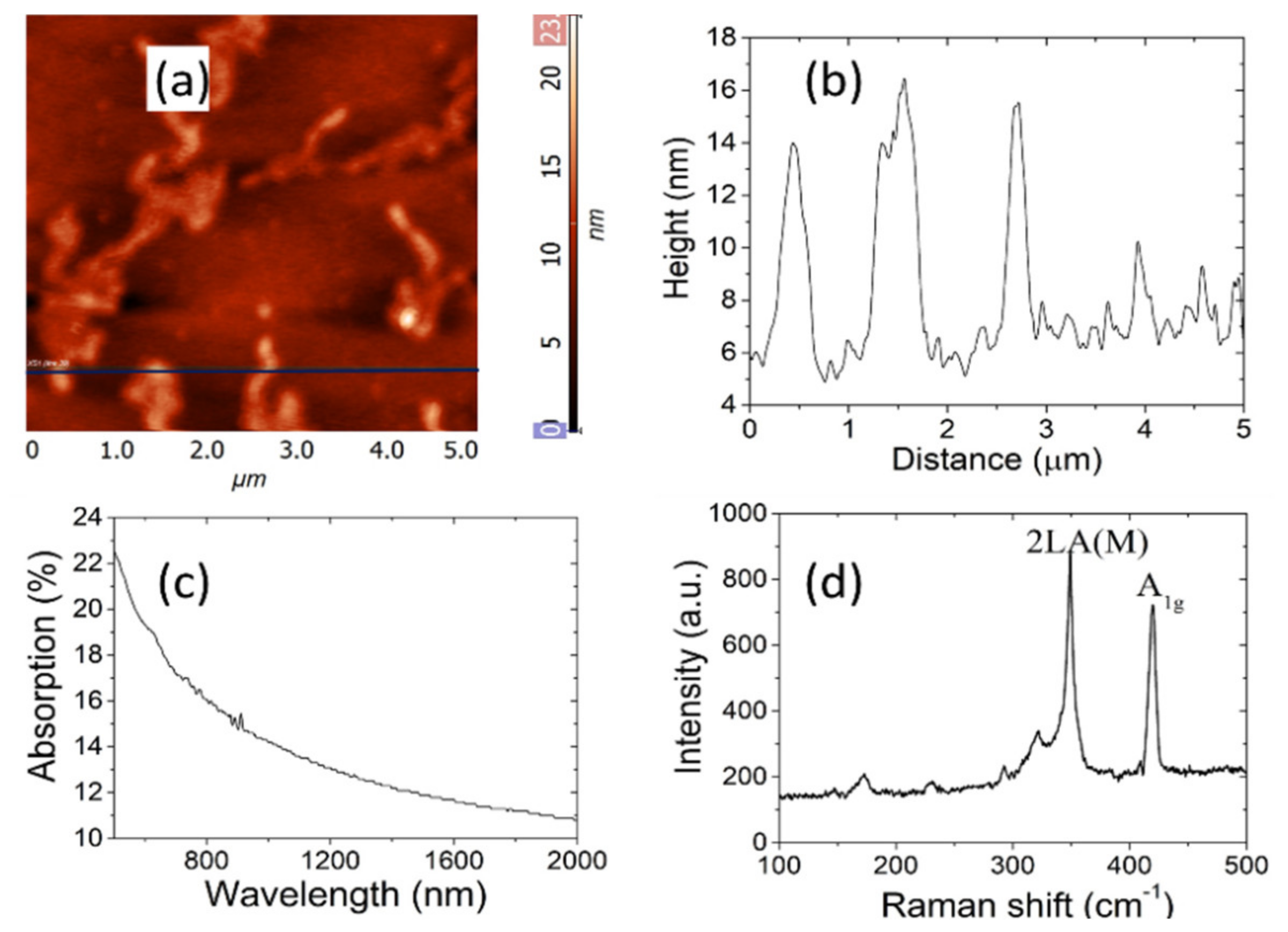
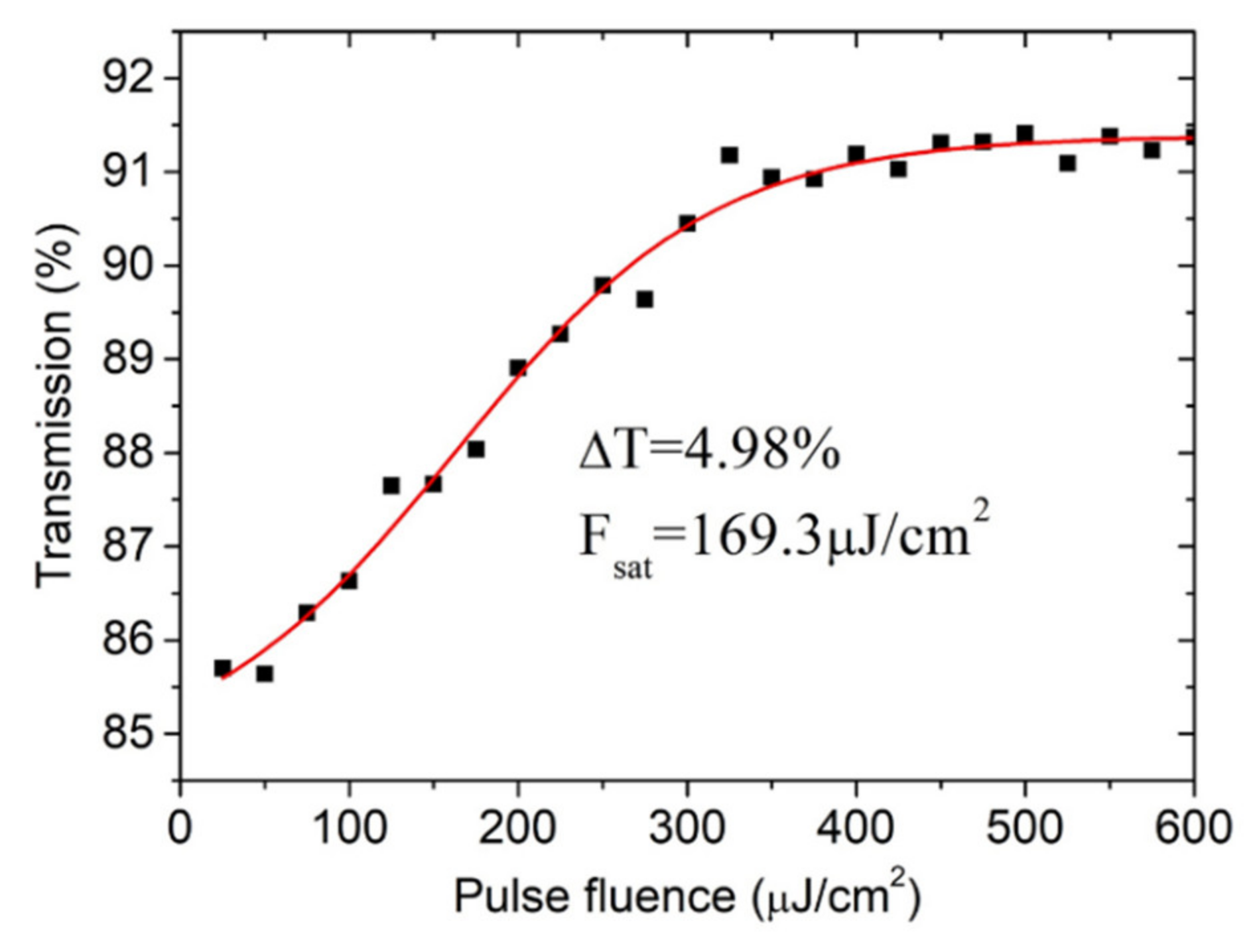
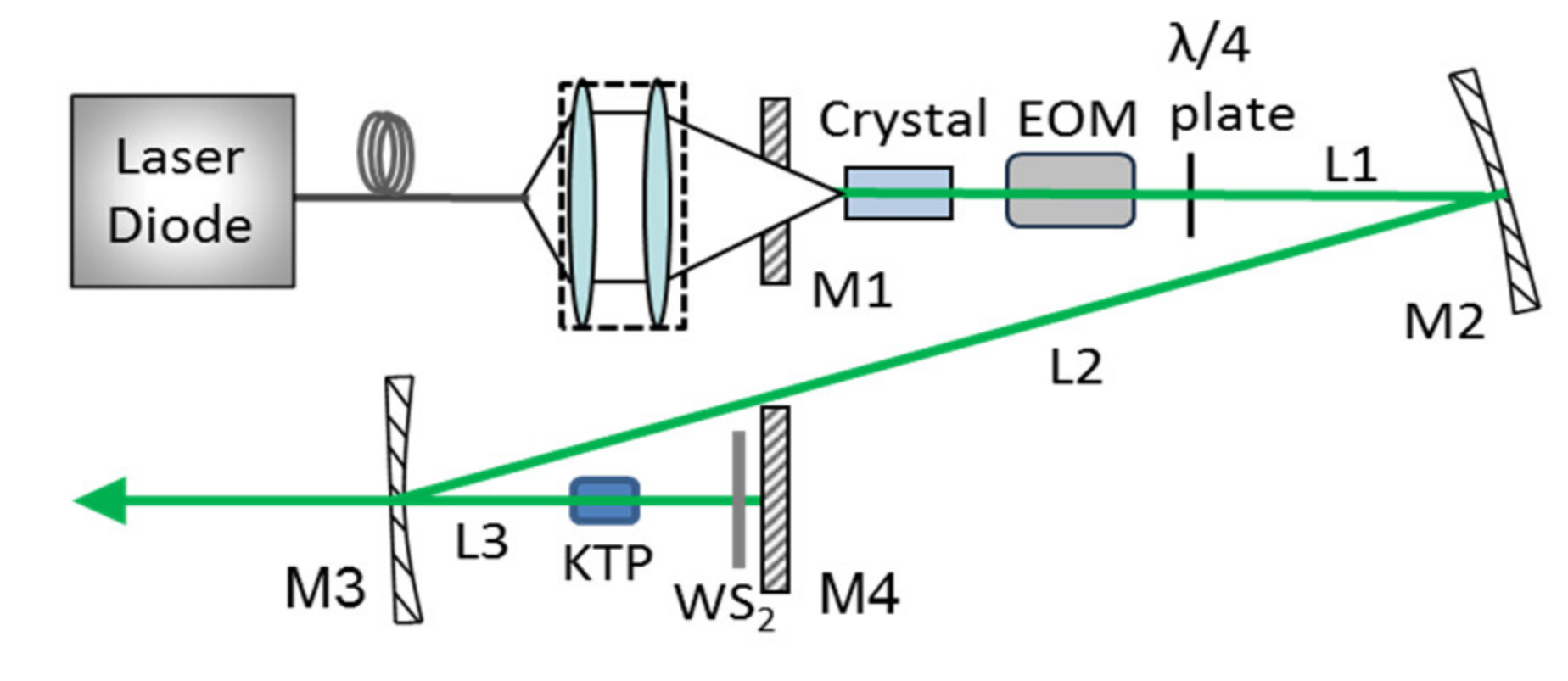
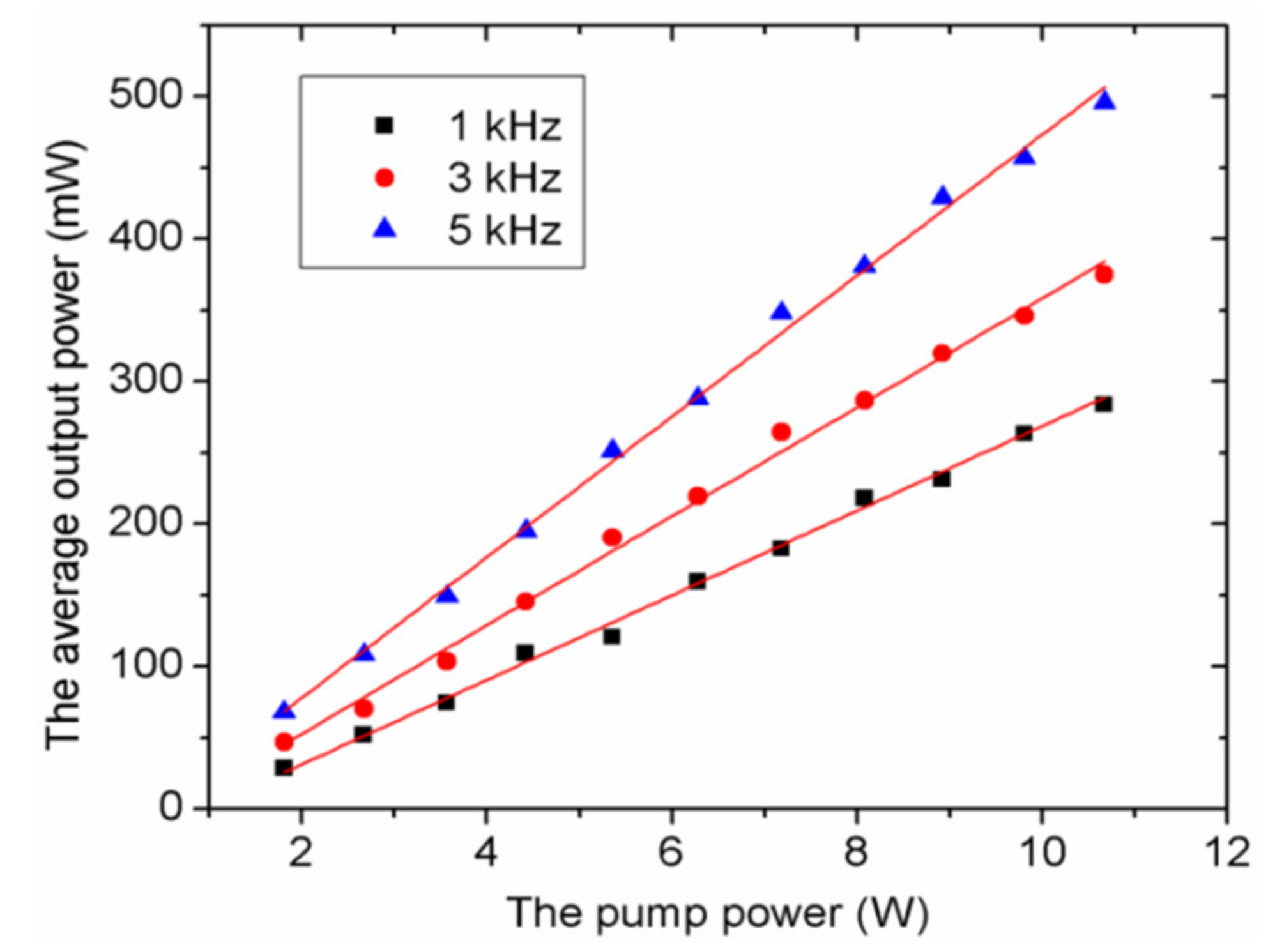
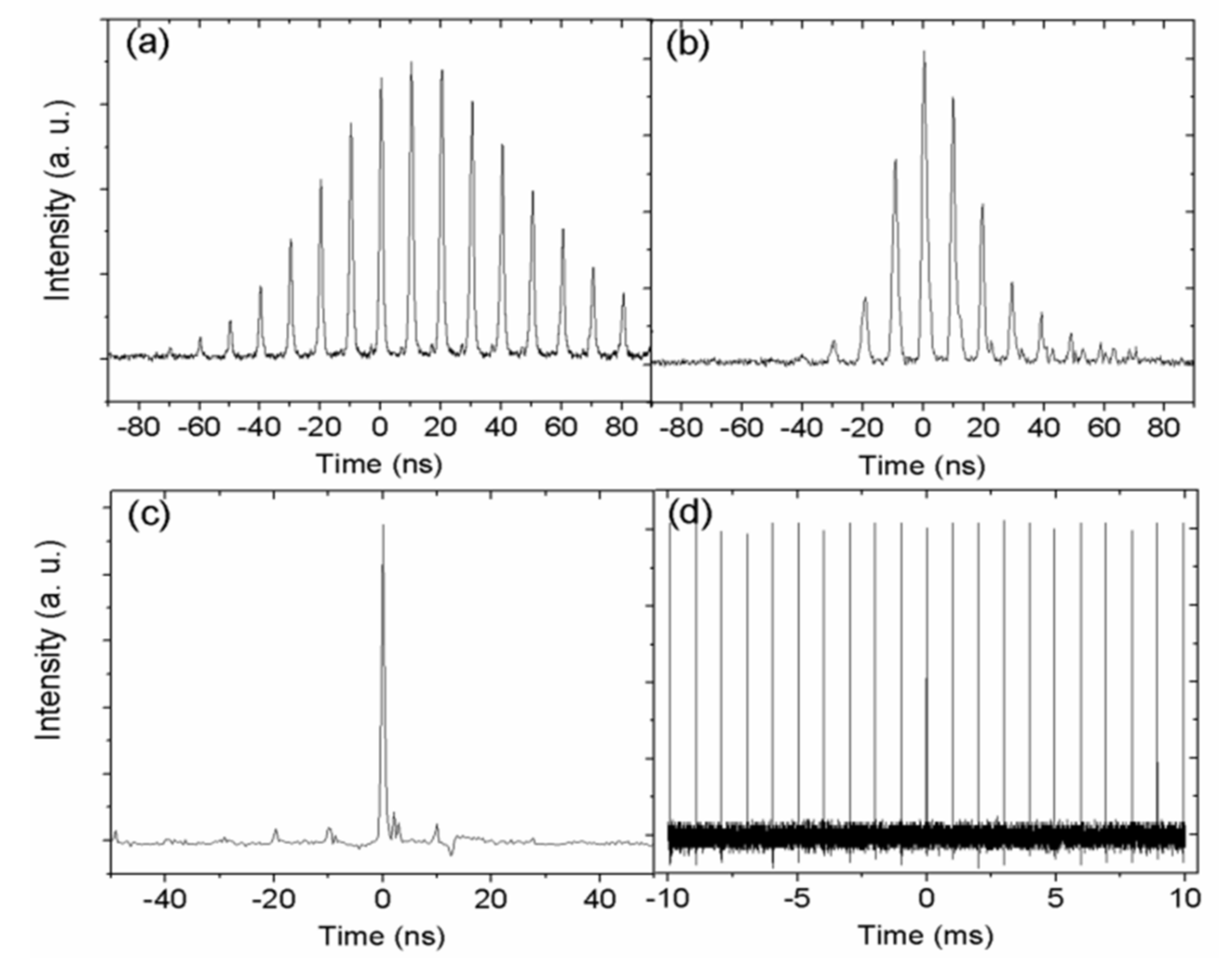
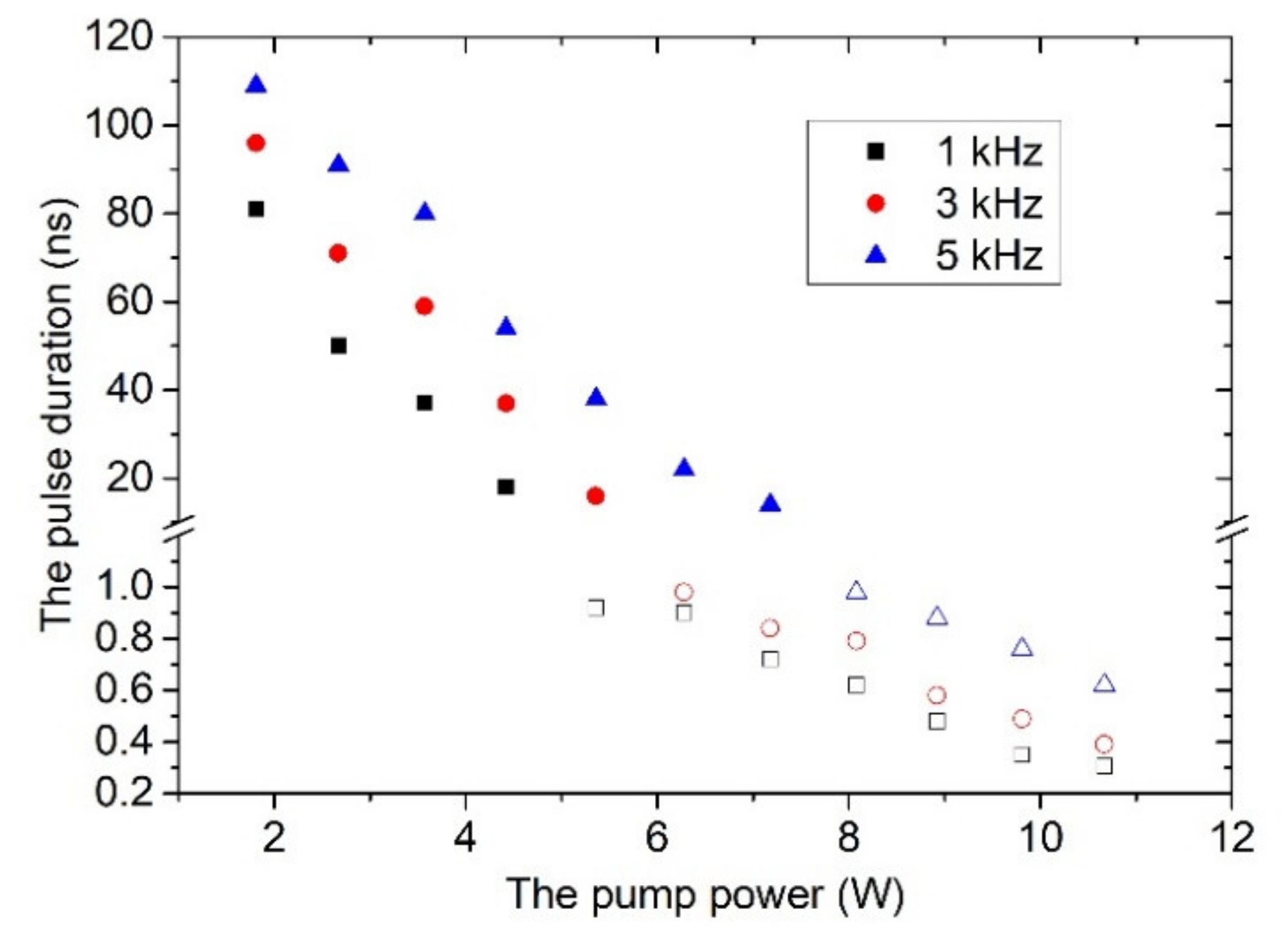
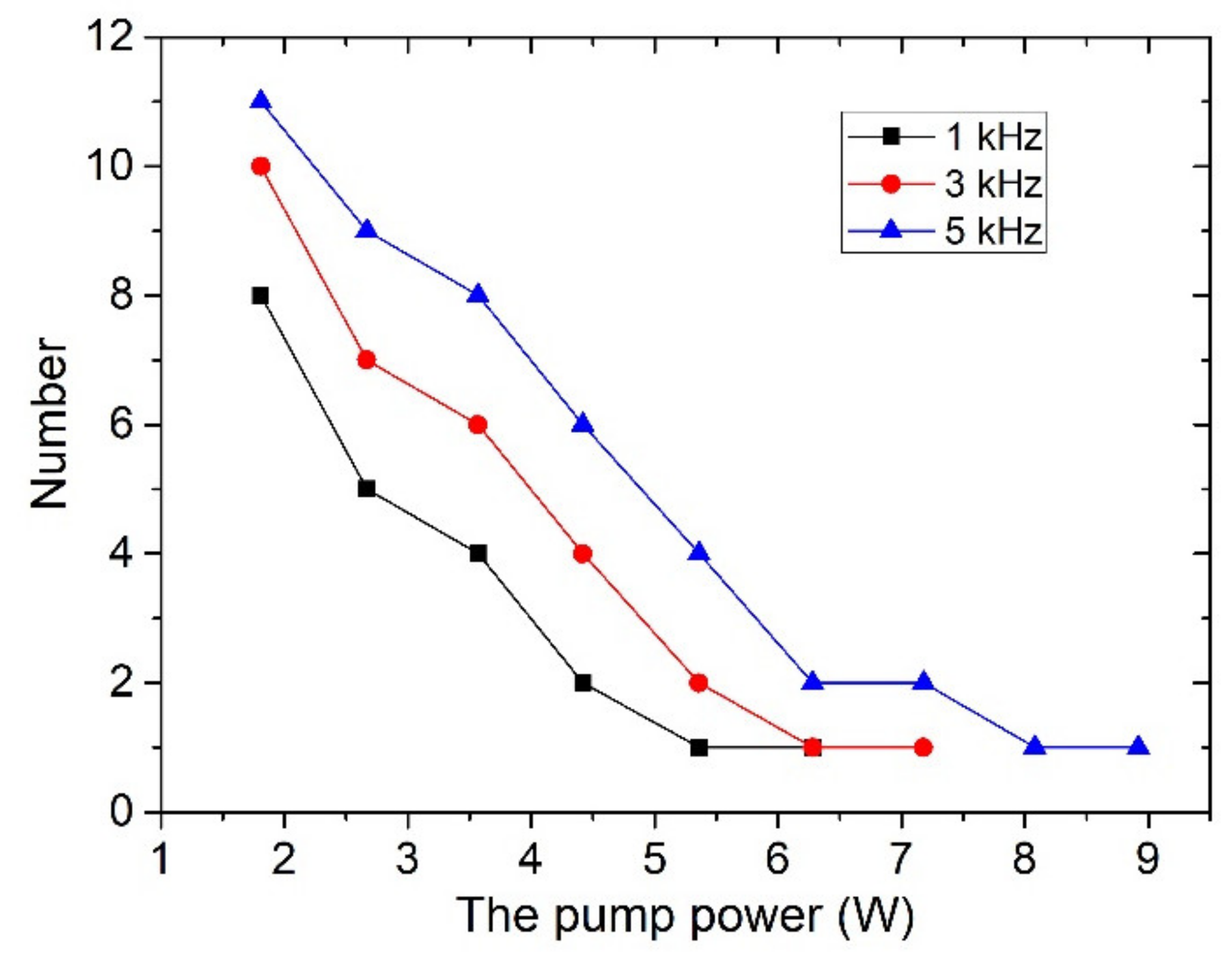

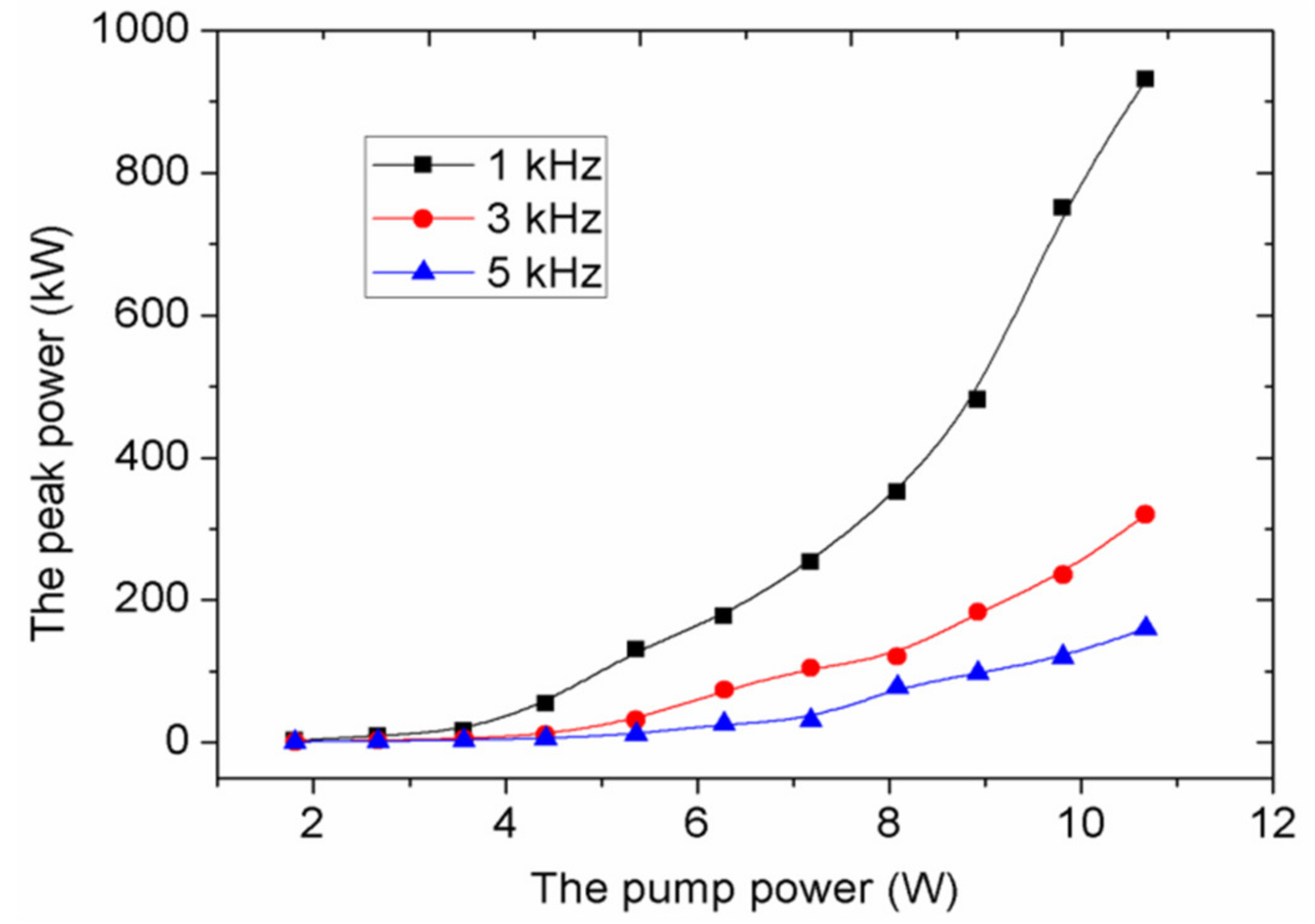
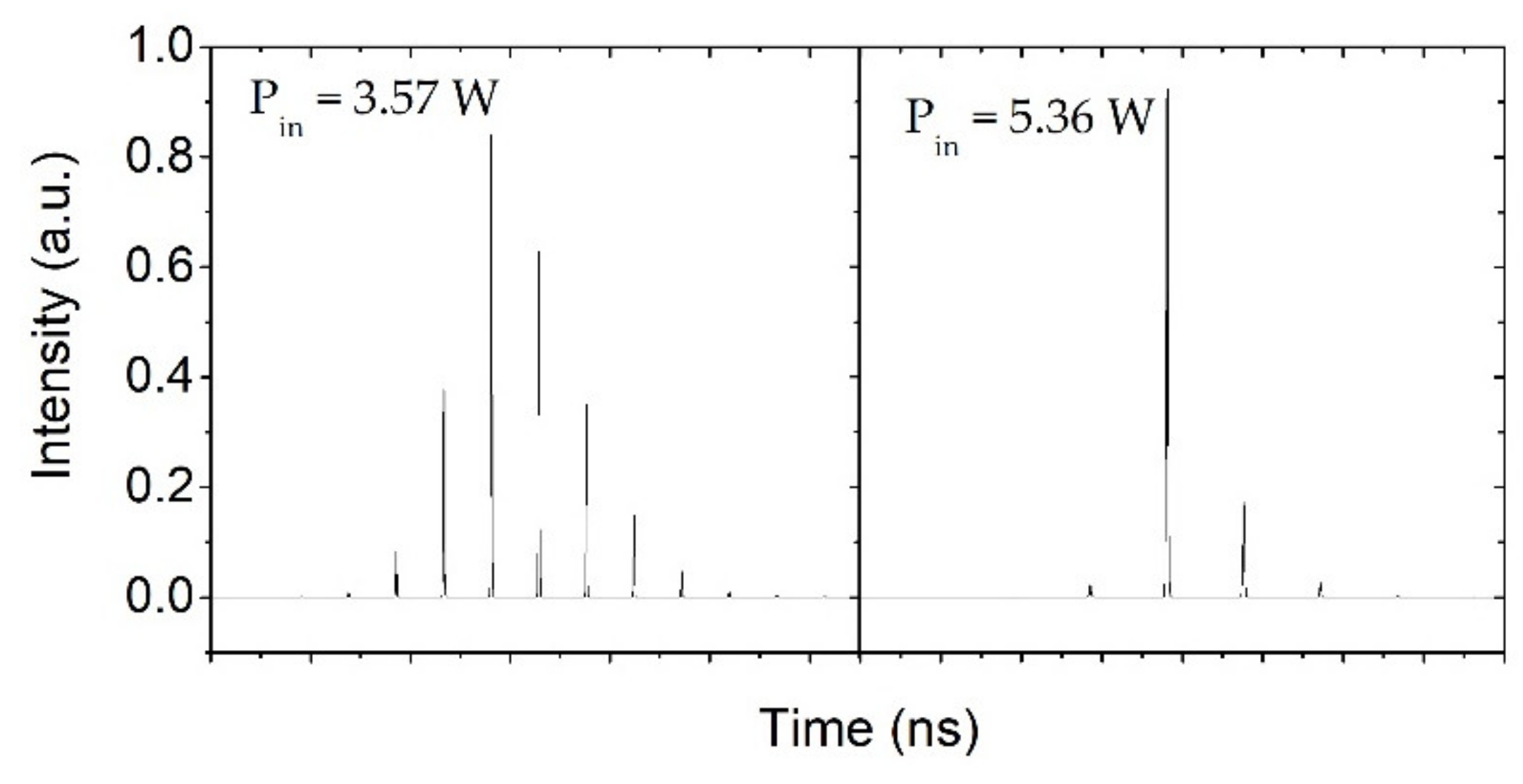
| Symbol | Values | Ref. | Symbol | Values |
|---|---|---|---|---|
| σm | 8.7 × 10−19 cm2 | [39] | lE | 50 mm |
| τm | 124 μs | [39] | ωA | 96 μm |
| α | 5.32 cm−1 | [39] | ωp | 200 μm |
| n | 2.045 | [40] | ωm | 300 μm |
| n1 | 1.65 | [40] | ωE | 121 μm |
| δe | 0.1 | [40] | ωkp | 106 μm |
| c | 3 × 108 m/s | [40] | ωl | 166 μm |
| L | 0.07 | αs | 0.0498 | |
| 200 ps | αns | 0.092 | ||
| la | 10 mm | d | 8 mm |
Publisher’s Note: MDPI stays neutral with regard to jurisdictional claims in published maps and institutional affiliations. |
© 2021 by the authors. Licensee MDPI, Basel, Switzerland. This article is an open access article distributed under the terms and conditions of the Creative Commons Attribution (CC BY) license (https://creativecommons.org/licenses/by/4.0/).
Share and Cite
Tang, W.; Sun, W.; Wang, J.; Jiang, K.; Xia, W.; Zhao, S. Generation of High Peak Power Mode-Locked Green Pulses Based on WS2 and EOM: Experiment and Theory. Molecules 2021, 26, 4406. https://doi.org/10.3390/molecules26154406
Tang W, Sun W, Wang J, Jiang K, Xia W, Zhao S. Generation of High Peak Power Mode-Locked Green Pulses Based on WS2 and EOM: Experiment and Theory. Molecules. 2021; 26(15):4406. https://doi.org/10.3390/molecules26154406
Chicago/Turabian StyleTang, Wenjing, Wanggen Sun, Jing Wang, Kai Jiang, Wei Xia, and Shengzhi Zhao. 2021. "Generation of High Peak Power Mode-Locked Green Pulses Based on WS2 and EOM: Experiment and Theory" Molecules 26, no. 15: 4406. https://doi.org/10.3390/molecules26154406
APA StyleTang, W., Sun, W., Wang, J., Jiang, K., Xia, W., & Zhao, S. (2021). Generation of High Peak Power Mode-Locked Green Pulses Based on WS2 and EOM: Experiment and Theory. Molecules, 26(15), 4406. https://doi.org/10.3390/molecules26154406






